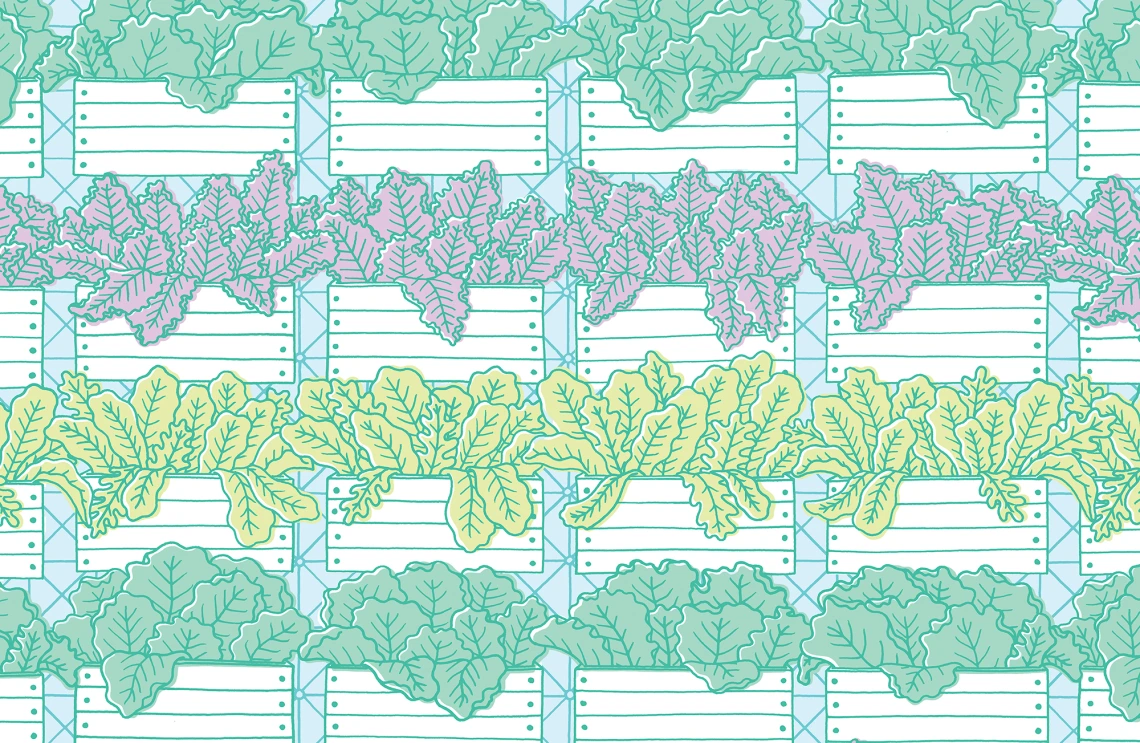Farming Straight Up

Margaret Kimball illustration
Paul Hardej doesn’t sound like a farmer. Rather than talking about soybeans, cotton or corn, he talks about economies of scale, technology challenges and commercial applications. And you aren’t likely to find dirt under his nails. But the Austin-based agricultural pioneer understands the brave frontier of indoor farming — controlled-environment agriculture — that’s changing the way we think about growing food.
Hardej is the co-founder of Civic Farms, a Texas startup that’s partnering with the UA to grow produce inside one of the diaphanous “lungs” of Biosphere 2. The Biosphere began life in the 1980s as an experimental, self-contained world in which groups of people were sealed for long periods to help test technologies for colonizing space. The role of the lungs was to relieve pressure inside the enormous glass facility.

Biosphere 2 (Jacob Chinn photo)
In 2011, the UA assumed ownership of Biosphere 2. Now that the experimental world is no longer sealed, the lungs will be used by Paul Hardej and Civic Farms. Hardej envisions the domed structure stacked high with racks of vegetables — more than 20,000 square feet of them — arugula and kale and lettuce, all flourishing in nutrient-rich water under the powerful glow of LED lights.
If all goes as planned, the project not only will be a commercially viable farming operation, with produce selling in Tucson and Phoenix, but also will provide invaluable, hands-on training for students through the UA’s Controlled Environment Agriculture Center (CEAC). Up to half of the lungs’ space will be devoted to its research projects.
The project promises to be a perfect marriage between the university’s controlled-environment expertise and the business savvy of Civic Farms. “We are a unique group of entrepreneurs,” Hardej says of his company, “one of the few groups that has actual experience in designing, building and operating vertical farms. Our real-life experience gave us the idea that we need to solve some of the problems with partners, rather than on our own.”
One of those challenges is making large-scale indoor farming efficient enough to be profitable. Murat Kacira, a professor of agriculture and biosystems engineering at the CEAC, says that water use can be 10 or 15 times more efficient in controlled environments compared with open farm fields. That kind of efficiency affects more than the bottom line. “[Controlled-environment agriculture] could become a primary alternative in locations where people might be really challenged in terms of access to a clean supply of water, a power supply or other materials needed for food production.”
“We’re not saying that food grown under controlled-environment conditions is going to be the sole source of food production to feed the ever-increasing population,” Kacira continues. “But we are saying that this would be a technology platform to help provide food needed by people, while optimally using resources.”
Under the agreement, Civic Farms will lease the space at the Biosphere for $15,000 per year. In return, the company will pledge $1 million to upgrade the facility and another $250,000 to hire student researchers. The students will operate under the auspices of the CEAC, and the project will draw on the Biosphere’s collective expertise.
“All these people are already there doing their own research,” Hardej says. “Climate change, energy, water, food — all these things are connected and centered there. It’s a fantastic resource for us.”
Hardej’s project has come a long way since its first incarnation a few years ago in an empty corner of the UA’s Campus Agricultural Center on Campbell Avenue. “That was a great platform for training,” he says of the early effort. “But it was very small.
“We came to the conclusion that it would be great to have a real-scale commercial farm, where you could take the technology, do some R&D, and apply it at scale to see if it really works or not. If it works, you can open your doors and train future operators, growers, executives or whomever to run the operation.”
In the meantime, the demand for locally-grown foods has made controlled-environment growing a hot commodity. But there are still challenges. Despite great advances in efficient lighting, for instance, high energy use remains an issue.
On the other hand, indoor farming offers enormous advantages over traditional field farming. Infestations and the need for pesticides are largely negated. Water use is much easier to manage. And, thanks to year-round production, yields can be up to 20 times greater per area than with traditional farms.
Those factors help explain the industry’s phenomenal growth; investments in agriculture startups such as Civic Farms reached $4.6 billion in 2015 — a nearly 100 percent increase over the year before. That dovetails with local-food revenues, which topped $11.7 billion in 2014 and are expected to surpass $20.2 billion by 2019.
The UA’s Biosphere 2, teamed with Civic Farms, is taking advantage of the market. “By itself, the Biosphere is a magnet,” says Hardej. “It draws 100,000 or more visitors a year. It also draws scientists, environmentalists and a lot of forward-thinking people. This represents a great opportunity to leverage that track record to promote vertical farming.”
